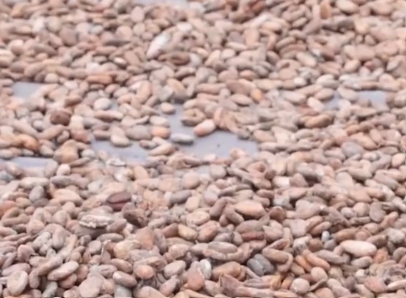Choclate prices are going through the roof. Here’s what’s going on…
The global cocoa market has experienced unprecedented volatility, with prices tripling over the last year, severely impacting the cost structure of many candy and food manufacturers. Cocoa prices, which previously stabilized around $2,500 per metric ton, surged to a record high of over $11,000 per metric ton in April, driven by concerns over a weaker-than-expected crop yield. This dramatic increase is causing a significant shake-up in the food industry, particularly for major candy producers like Hershey, Mars, Ferrero, and Mondelez.
These companies, traditionally reliant on long-term contracts to hedge against price fluctuations, are facing impending financial strain as these agreements are set to expire by 2025. The situation is exacerbated by supply issues primarily originating from West Africa, which is responsible for the majority of the world’s cocoa supply. The region has been plagued by crop diseases and low farmgate prices, which discourage farmers from cultivating cocoa, pushing them towards more profitable crops like rubber.
Cocoa Prices Soar to Record Highs Amid Cameroon’s Conflict-Driven Supply Crisis
The world market’s enormous demand for cocoa has driven up its price to an all-time high, but there isn’t enough of the commodity to sell in Cameroon’s major cocoa production basin. pic.twitter.com/xEPnmvwAgQ
— VOA Africa (@VOAAfrica) June 11, 2024
The recent decision by Ghana, the world’s second-largest cocoa producer, to delay the delivery of up to 350,000 tons of cocoa beans to the next season has added more pressure, propelling prices even higher. Industry experts anticipate this could lead to the largest cocoa deficit in over six decades, as stated in a report by Rabobank.
In response to these challenges, food companies are exploring various strategies to mitigate the impact of rising cocoa costs. Some are considering recipe reformulations to reduce cocoa content without compromising product quality. For instance, substitutions with less expensive ingredients like sugar, cocoa butter equivalents, and various oils are being tested. Others, like J&J Snack Foods, are contemplating adjustments to their product offerings, such as reducing the number of chocolate chips in their products to maintain cost-effectiveness.
“China’s Cocoa Bean Market Report 2024 – Prices, Size, Forecast, and Companies” https://t.co/OomEhTHaxN
— Henry Muldrow (@HMuldrow42115) June 15, 2024
Amidst these operational adjustments, companies are also facing consumer pushback against price increases and “shrinkflation,” where the quantity of a product is reduced while its price remains the same. A survey by YouGov highlighted that a majority of U.S. consumers are increasingly aware of such practices, which may influence purchasing decisions unfavorably.
To diversify risks associated with cocoa price volatility, some companies are expanding their product portfolios beyond chocolate. Hershey, for instance, has added more salty snacks to its offerings by acquiring brands like SkinnyPop and Dot’s Homestyle Pretzels. This strategic shift not only responds to changing consumer preferences but also reduces the company’s dependency on cocoa.
Furthermore, the cocoa supply chain is under scrutiny for ethical reasons, including the use of child labor and slavery in West African cocoa farms. These issues have led to lawsuits and have tarnished the reputations of chocolate producers, compelling them to consider more sustainable and ethical supply practices.
Could it be that Cocoa prices don’t effect because Oreo doesn’t have any Cocoa in their chocolate cookies?https://t.co/qQpgTk88YE
— Grave New World (@spudflyer) June 15, 2024
Looking ahead, while companies may find temporary solutions through product innovation and portfolio diversification, the underlying challenges of volatile cocoa prices and ethical supply concerns will likely necessitate more fundamental changes in the industry. As these companies navigate through these turbulent times, their ability to adapt and innovate will be critical in maintaining competitiveness and consumer trust.
Key Points:
i. Cocoa prices have surged to over $11,000 per metric ton from around $2,500 due to concerns about weak crop yields, significantly impacting candy makers and food companies.
ii. Major companies like Hershey, Mars, Ferrero, and Mondelez are currently shielded by long-term contracts but face higher costs once these expire by 2025.
iii. The crisis is exacerbated by factors in West Africa, the leading cocoa-producing region, where diseases and low farmgate prices push farmers toward more lucrative crops, potentially leading to the largest cocoa deficit in decades.
iv. Companies are exploring strategies to mitigate the impact, including recipe reformulation to reduce cocoa content and diversifying product lines to include fewer cocoa-dependent products.
v. Consumer resistance to price increases and “shrinkflation,” ethical concerns regarding the cocoa supply chain, and the need for sustainable practices are pressing challenges that the food industry must address.
RM Tomi – Reprinted with permission of Whatfinger News



